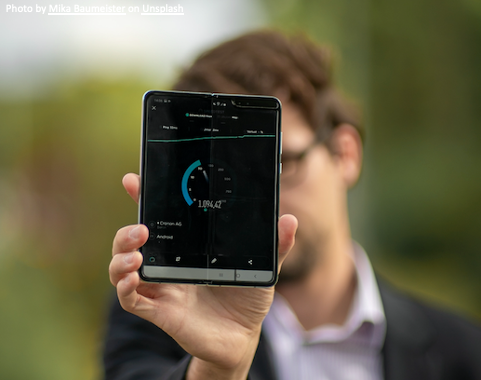Veteran sports broadcaster, Joe Buck, kicked off 2020 Super Bowl coverage with a stirring sports adage, “This is the first Super Bowl featuring 5G ultrawideband!” Later my screens endured a relentless pop-up from something called, ‘Breakthrough Investor:’ “5G Could Be The Single Biggest Investment of 2020.”
To stand out in the crowded 5G spectrum Bloomberg recently utilized headline rhyming and images of angry little green men: “Debt Tantrum From Space Forces US Hand in 5G Race.”
Though 5G is coming on stage, what it will deliver and when you will benefit carries much uncertainty and is clouded by promotional hype. It will in fact provide significant benefits for connectivity and productivity while whetting our appetites for even more.
5G In Terms That You and I Can Understand
Called “5G” because it’s the fifth generation of wireless technology for digital cellular networks, it is not merely a faster connection. 5G is a collection of improvements over today’s 4G or “Long Term Evolution” (LTE) including better radio technology, geographically smaller cells, and more data links per chunk of bandwidth that together converge in higher speed, better availability, and greater reliability.
The most noticeable user benefit, higher bandwidth or how fast data can be sent and received, is also the most confusing for potential customers. 5G comes in three flavors that can all regrettably be branded “5G” though their speeds differ by over one hundred times:
- Low band: radio frequencies of 600 – 700 megahertz (million times per second, MHz), and data rates as low as the best performing LTE: ~25 megabits per second (million bits per second, Mb/s).
- Mid band: radio frequencies of 2.5 to 6.4 gigahertz (billion times per second, GHz) and data rates reaching 1.5 gigabits per second (billion bits per second, Gb/s). That’s forty times the best LTE rate.
- Millimeter Wave (As the name says, the wavelengths are around a few millimeters long.): radio frequencies up to 71GHz and data rates to a theoretical maximum of 35.4Gb/s or 140X the best that you’ve likely ever seen on your 4G phone. Everyone will want that. The actual reliably available rate may be 10Gb/s, and everyone will still want it.
A 400X difference in the most important benefit under the same product name will be a nightmare for consumers, annoying for industrial buyers and sellers, and a tempting lever for practitioners of the dark side of marketing.
5G has a few other quirks:
- Thanks to physics, millimeter waves offering the fastest connections can only cover short distances. Count on only a mile or so of good reception from a millimeter wave transmitter.
- Those waves either bounce off or are blocked by pretty much anything in their path. You’ll need a line-of-sight to the cell tower or fortunate bounces off of buildings. It’s going to be a trick to get that signal on tree-lined street, or to keep it while you’re moving around a city.
- They won’t penetrate buildings, either. That’s right: you won’t get the fastest 5G connections directly to your phone inside a building, even through windows, until the laws of physics change or you get an office with windows that open. The indoor solution will be faster Wi-Fi, now called Wi-Fi 6, with data carried to and from your building by 5G or fiber. (When your mobile phone cannot get a millimeter wave 5G signal indoors it will just connect to a slower available service, like LTE, that does penetrate buildings.)
Benefits That You and I Can Appreciate
Even with that weirdness 5G is still important for you. It can deliver very low latency, the time lag between when a transmission is requested and when it starts (Analogous to the time lag between when you ask your teenager to take out the garbage and he actually does it: shorter is better.). 5G base stations, the hubs that network “edge devices” like your phone connect to, can handle a million connections compared with 4G’s 4,000. What do the faster bandwidth, lower latency, and greater connection density really mean for us?
Let’s start with Netflix: 60% of last year’s downstream internet traffic was video streaming. Humankind has an insatiable appetite for Game of Thrones, YouTube channels, and cat videos of all genres. With millimeter wave 5G HD movies will download in a few seconds: why not just download your content and watch whenever/wherever without worrying about your internet connection? Business models depending on pop-up ads during streaming content need to consider this coming capability.
Even if you are one of the few humans who can actually see a meaningful video quality different between HD and 4K video on a 5.5-inch phone display, or you are like me and enjoy lounging in front of as big a display as your family room wall can support, 5G has you covered. 8K movies will download in a minute or two. Telecommuters will enjoy video conferencing supporting an 8K video stream plus an HD travel IRL playing in a quarter of your screen (not that you would ever multitask like that…).
Such rapid data transfers can also offer peace of mind. Worried about a ransomeware attack? At 1Gb/sec transfer rates you could upload 30GB of your data and files in four minutes.
In addition to enhancing our individual entertainment and productivity, 5G’s advantages can be heavily leveraged for the industrial Internet of Things (IoT). Audi, BMW, Daimler, and Volkswagen have expressed interest in managing proprietary 5G networks, as have large chemical, gas, and oil companies; utilities; and major shipping ports. Workers will quickly and reliably access augmented reality (AR) content for training and information. The million sensors and actuators that can be connected in a single 5G cell could cover a sophisticated factory operation. 5G is harder to hack than Wi-Fi plus there are no cables to slow down frequent physical reconfiguration of flexible production schemes. When the cell transmitter is on your factory floor the waves don’t have to go through walls, and anyone looking to sniff your wireless traffic would literally have to be on the inside.
While the connection to your phone or a sensor in a factory is the last leg of a cellular network, one of 5G’s most important applications will be supplanting wired connections to a building. From there a Wi-Fi 6 or other high-bandwidth wireless system will make a high-performance connection to everyone and everything within. It will be profoundly cheaper and more convenient to install 5G transmitters and receivers than it will to string new cables or dig new trenches to every house or building.
New Zealand will use 5G as part of the solution for reaching the final 10% of its rural population with broadband internet. Enhancing broadband coverage is a big deal not only for rural areas but especially for the dense mega-cities magneting ever larger portions of our global population.
5G is a promising piece in the global rural connectivity opportunity. Four billion is a tempting new market, especially with global smart phone sales to the connected growing flat. High-profile satellite constellation projects like SpaceX’s Starlink and Jeff Bezo’s Project Kuiper will add an important missing network link to far-flung locales, but someone still needs to build stations on the ground: a smartphone in the middle of the Serengeti will not connect directly to a satellite.

Issues of culture and politics stand alongside those of technology in not merely connecting the four billion unconnected but in enabling them to benefit from that connectivity. If a community does not perceive benefits in connectivity, it will not want to invest in or use the service. The opportunity and solution involves much more than technology and infrastructure. The rural connectivity opportunity extends to beyond technology companies to NGOs, educators, and local and national political leaders.
Telemedicine is another multifaceted global opportunity that can leverage 5G. Quickly becoming a well-accepted paradigm for improving healthcare access, telemedicine will benefit significantly from greater and more frequent patient data from patient-local sensors and wearables. “Ping An Good Doctor,” an internet health care service company in China, has 300 million registered users with use skyrocketing in the wake of the coronavirus outbreak. It’s Hong Kong traded shares have shot up 30% this year. Availability of high-quality digital diagnostic and monitoring devices is exploding and will continue to push the need for available, secure, highly-reliable cellular data service.
When will we see these benefits? It took 30 years to erect 150,000 cell towers for 4G and a good part of the global population is uncovered. 5G transmitters are smaller, but millimeter wave networks will need five times as many installations. A political race between the U.S., China, South Korea and others will hasten high-profile location roll-outs (The first 5G network was used at the 2018 Pyeong Chang Olympics. Aren’t the Olympics a convenient forum for national branding?). Companies can invest in private 5G networks now, and many carriers are advertising “5G” availability. You may be able to access 5G right now: just be sure to ask smart questions about what flavor of 5G you’re really getting.
Even with such numerous benefits and opportunities with 5G, there is plenty that it won’t do. We will soon want 6G, and more.


